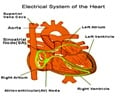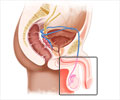New clinical test detects Calcium Release Deficiency Syndrome (CRDS), a genetic arrhythmia with rapid heartbeats leading to sudden cardiac arrest.

A Clinical Diagnostic Test for Calcium Release Deficiency Syndrome
Go to source). The new diagnostic method monitors for changes in electrocardiography (ECG) after a brief period of a fast heartbeat and a pause, which can occur naturally or be induced by artificially pacing the heart.
‘A simple test now detects a rare and fatal #genetic #heart condition, offering hope for early intervention and better outcomes. #heartdisease #genetictest #heartattack ’





This research was co-led by Jason Roberts, a scientist at the Population Health Research Institute (PHRI), a joint institute of McMaster University and Hamilton Health Sciences, and Wayne Chen, a scientist and professor at the Libin Cardiovascular Institute and Hotchkiss Brain Institute at the University of Calgary's Cumming School of Medicine, and published in JAMA. What is Calcium Release Deficiency Syndrome
While 60,000 cardiac arrests occur annually in Canada, CRDS remains undetectable with standard clinical tests, often resulting in the cardiac arrests being labeled as unexplained. This gap in understanding the underlying cause prevents the delivery of optimal care to survivors and vulnerable family members who may be affected by this genetic condition."This novel and simple diagnostic method, which can be performed using an electrocardiogram in a broad range of clinical settings, is hopefully an important step towards improving our evaluation of initially unexplained cardiac arrest (UCA)," said Roberts, co-principal investigator of the study.
Roberts and Chen led this multi-centre case-control study involving 68 study participants from 10 centres in seven countries. The participants were from four categories of heart conditions, including CRDS patients and UCA survivors. Accompanying studies from Chen’s lab revealed findings in genetic mouse models that mirrored those observed in humans. The mouse studies also provided insight into the underlying cellular mechanism responsible for this apparent ECG signature of CRDS.
"CRDS has been linked to many tragic incidents and heartbreaking stories affecting families. There have been numerous cases where patients experienced fainting episodes, but their tests showed no issues, which led doctors to believe the fainting was not due to a dangerous heart condition. A portion of these individuals, often young and otherwise healthy, subsequently suffered sudden cardiac arrests, and some did not survive," said Roberts.
Advertisement
The study marks the initial stage of Roberts and Chen's efforts in further exploring a diagnostic approach for CRDS and collecting additional data as part the ongoing PHRI DIAGNOSE CRDS trial. This trial represents a broader, international initiative aimed at strengthening their conclusions. Currently in the recruitment phase, DIAGNOSE CRDS aims to enroll 500 participants from 30 sites across 10 countries.
Advertisement
The team anticipates this simple pacing test will be incorporated into the routine diagnostic tests for initially unexplained cardiac arrest, providing hope for better outcomes and prevention of future tragedies.
“This is an important discovery because there is an urgent need for a clinical diagnostic test for CRDS,” says Chen. “This will allow us to identify individuals at risk, better understand the prevalence of CRDS and, hopefully, develop treatments for the condition.”
Reference:
- A Clinical Diagnostic Test for Calcium Release Deficiency Syndrome - (https://jamanetwork.com/journals/jama/article-abstract/2820283)
Source-Eurekalert















